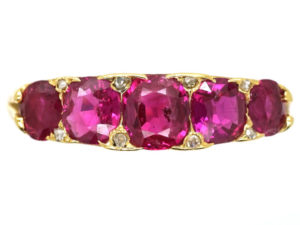
Each year, summer officially begins just as the zodiac shifts from Gemini to Cancer, on June 20 or 21, which also loosely corresponds to the summer solstice. On the first day of summer, the sun reaches its highest point in the sky, and it’s the longest day of the year.
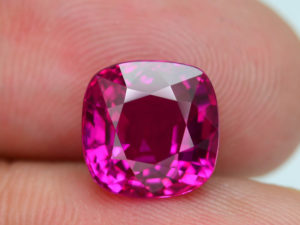
Cancer crab-walks into the limelight between June 21 and July 22, replacing Gemini’s flighty, light-as-a-feather Air-effects with the power of Water, Cancer being the cardinal Water-sign, meaning it’s the most watery, surpassing Pisces and Scorpio. More than a century ago, while studying alchemy, Carl Jung identified water as symbolic of the Collective Unconscious, and also of emotional depth. As the most definitive Water sign, and as the child of the moon, Cancer’s ruling planet, the Crab is the most intuitive critter in the zodiac. And not the sign most prone to tears: that would be Scorpio, who holds emotions in until they implode, and Taurus, who tends to view E-V-E-R-Y- thing as a crisis (luckily, most Taurean crises can be quickly remedied with brownies and chocolate chip cookies).
First, a word about the sign’s name. It’s not easy scuttling across the cosmic sea-floor when you share a name with humanity’s most dreaded family of diseases! The disease is named because the malignancy often sends out long, creepy legs, more like that of a spider than a crab. But the unfortunate naming is Cancer’s shell to bear.
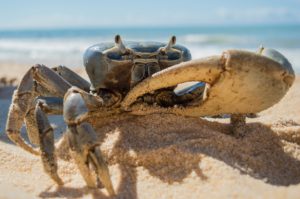
Another mystery: why there is any question about Moonstone being Cancer’s gem, given the planetary influence? Instead, Moonchildren are identified with a precious jewel in a color that doesn’t suit the Crab: the gem is Ruby and the color is, of course, Ruby-Red. While there’s no legislating taste, Moonchildren tend to avoid primary red because it’s so raw, and seems unimaginative to the refined Cancerian sensibilities. Crabs prefer to wear white, or sea-green, turquoise, teal, lavender, deep purple, periwinkle, and every shade of pink—the latter enjoying a momentary renaissance in 2022 as “the only true rock-and-roll color” according to MGK.

So, let’s examine the rock. Many Rubies take on a deeper violet tone, while others look like cherry lifesavers. In either case, the gem has been associated with blood for centuries. This association means many things, from valor on the battlefield to red-blooded courage in personal matters.
Rubies and their blood-association are historically linked with the heart, and so many civilizations promoted the wearing of Rubies not only for gumption, but also to stop bleeding and strengthen cardiac activity. In ancient Burma, warriors engaged in a form of early bod-mod lithotherapy by inserting Rubies under their skin as a talisman before going into battle. In medieval Europe, Rubies were believed to turn black in the presence of danger, and were worn as both prevention and cure for the Black Death by those who could afford them.
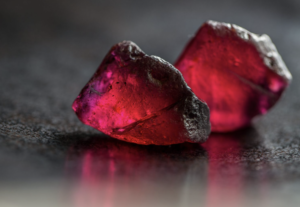
Again, this may be interpreted literally as well as metaphorically: it was believed that a Ruby could invigorate a sluggish heart and improve circulation on a physical level, but was also linked with romance and sexual desire. This literally sanguine aspect of the Ruby has made it a favorite for wedding jewelry for centuries. In Victorian England, wearing Rubies not only broadcast your personal wealth, but also trumpeted Britain’s sovereignty over India and other South Asian holdings.
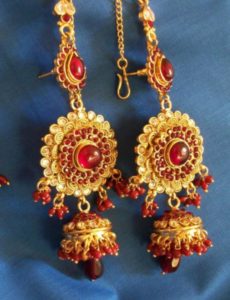

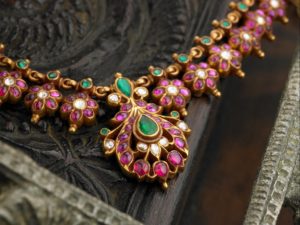
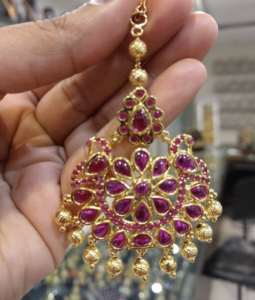
In “The Wizard of Oz,” Dorothy relied on her Ruby slippers to carry her safely home to Kansas after protecting her from the Wicked Witch of the West, apple-throwing haunted trees, flying monkeys, and loads of other fairytale mayhem.

In fact, the story of the Ruby slippers is so beloved that jeweler to the stars Harry Winston created a replica of the pair worn by Judy Garland in the 1939 movie. Garland’s originals glittered with red sequins, while Winston’s interpretation was inlaid with 4,600 premium Rubies totaling 1,350 carats, with 50 carats of diamonds for extra sparkle. Winston’s Ruby slippers sold at auction for $3 million in 1989, commemorating the 50th anniversary of the MGM classic film. Their value today can only be imagined.
Fourteen years later, celebrity shoe designer Stuart Weitzman was inspired by Dorothy’s Ruby slippers in 2003 to create a cherry-red pair of stilettos that sold at Harrods of London for $1.6 million. Weitzman used 642 Burmese Rubies totaling more than 120 carats to adorn the shoes, affixing the gems in place with 123.33 carats of platinum thread.
Cancer as the Cardinal Water Sign, ruled by the fickle moon, has dominion over the breasts and belly, truly making the Moonchild the keeper of all things Yin. Some modern practitioners align the sign’s association with both the waxing and waning Moon and the blood-red Ruby as making Cancer the protectress of women’s monthly cycle. And some wags maintain that sensitive (sometimes moody, moony) Cancer is in a perpetual state of PMS.
From prehistory forward, Ruby has among the most coveted gems on earth. To start with, Ruby scores 9.0 on the Mohs Scale, meaning that only the Diamond is tougher. Needle-like flaws or inclusions are common in Rubies, and these inclusions are called “silk” by gemologists. Only a synthetic stone is perfectly transparent. The rutiles are proof that the stone is organic, versus lab-created. When the rutiles cross to form a 3-point or 6-point star, these inclusions significantly raise the value of the stone as a Star Ruby. Rarely, Rubies exhibit other exceptional qualities, like the ability to color-change, or chatoyancy, meaning that the stone takes on a cat’s eye effect (similar to the star-formation, but fewer rutiles), which also greatly increase the market value of the Ruby.

Ruby belongs to the mineral family called Corundum, taking its pigeon’s blood color from the presence of Chromium in the soil as the stone formed. If the gem occurs in other colors, it will often be classified as a Sapphire, since the chemical composition of all Corundums is the same. By 600 CE, Rubies mined in Burma (now Myanmar) were the most sought-out gem on earth. These Burmese Rubies display the color that we most easily associate with the gem: a deep blood-red, tempered with a violet or electric pink sub-vibe. Rubies are still mined in Myanmar and many other sites around the world, but none match the traditional Burmese Ruby for depth of hue and brilliance of refraction, even when in cabochon (unfaceted) form. As a result, most modern Rubies are heat-treated to elevate their color and diminish the visibility of their rutiles.
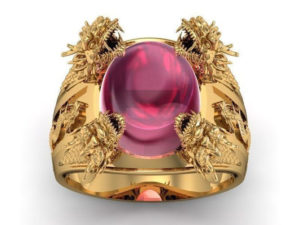

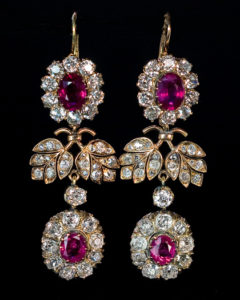
Which brings us back to the Birthday Crustacean. This sign is often on the quiet side, although the Crab’s natural talent for language, and love of writing, reading and study typically make the Moonchild a fascinating conversationalist, once the initial reserve has been dissolved. If you’ve never really known a Cancerian, you might go along with the shorthand that Moonchildren are downers. This is somewhat more true when a Moonchild is young, because the tidal pull of those lunar changes can indeed elicit melancholy.

But the saving grace of the Crab is a deep love of family and home-life, kept fluid and lively by the fast-running Water element and the constant wanderings of the moon. Taurus, for example, is an equally good homemaker and cook, but tends to get stuck in the tedium. Cancer secretly loves to clean the house, making the Crab a natural ally with earthy Virgo. These two can happily spend a weekend with a Q-tips and wet rags, making every corner sparkle. Good times.
Whether Cancer has natural children or not, the Crab is a born mother (this definition can include very nurturing men!). Cancer defines family as those who gather together with love, regardless of their DNA, broadening the potential for contact and connection. This is a healthy tendency, since Moon people can tend to isolate, not because they’re truly anti-social, but because they need downtime to recharge.
Caring for others, whether serving guests at a lavish dinner party or watering a neighbor’s petunias during a heat wave, is Cancer’s truest nature. Cancer is the Zodiac’s best host and party-planner, with an artist’s instinct for food preparation and plating, as well as devising a truly scintillating guest-list. This sign loves to pamper loved ones, and is a thoughtful, extravagant gifter. When the Crab stops giving generously, something’s wrong: the Crab is apparently wounded and sulking about something.
For true insight into the Cancerian personality, consider the creature bearing its signet. Free-swimming crabs present a rock-hard shell to the world, a pre-emptive strike against harm. But every season, that armor splits and shatters as the crab grows. For a brief period, the molting crab is as soft as jelly, without protection. The lunar nature of Cancer reflects this cycle as well, with a tough exterior masking a tender nature and an oft-broken heart.
And consider the hermit crab! The quintessential homebody who literally never leaves home. The front end is formidable, with impressive claws, but the back end is a soft squiggle of defenseless crabliness, hastily tucked into a borrowed shell. The anatomy of the crustacean really is the perfect metaphor for the Cancerian who has learned to protect extreme sensitivity with a hard casing. Healthy Cancerians, however, can easily shed the shell and express their need to nurture by pouring love-energy into their intimate relationships, close friendships, pets, home, and garden.
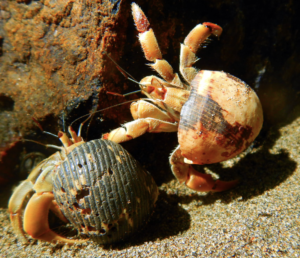
No one on earth can match a Cancerian in terms of attentive loving. The Crab remembers birthdays, sends flowers “for no reason”, loves to invite, decorate, host, cook and entertain, and is typically the friend you call for an emergency airport run, or when you’ve just discovered a litter of feral kittens in your garage. Cancer to the rescue!
The crab’s unique gait, moving in sidelong, oblique fractals instead of directly confronting what lies ahead, is an accurate assessment of how Cancer operates. When Cancer is interested in someone or something, the Crab will often move off into the distance to take in the view from several vantage-points before making a move.
This distancing-and-oblique appraisal practice of the Crab often drives impatient love-objects to distraction, especially if they conclude that Cancer’s merely playing hard to get. This usually is not the case, however. More likely, the Crab is utilizing the power of observation to form a strategy. This sign is one of the most patient in the Zodiac, opting to forgo instant gratification for a better prize, even though stormy sea-changes may surge beneath that placid exterior.
Although Water signs are credited with flexibility, neither the Crab or July’s bad-girl sister, Scorpio, like to let go once they’ve closed their claws around an item of interest. Only Pisces, always swimming upstream and downstream in the same instant, can move on easily. Cancer is often sentimental early in life, saving every birthday card, every toy, every vacay snapshot. Then, in middle-age, Cancer often goes Kondo, discarding ephemera with surprising stoicism. This is one of the reasons that Cancerians are excellent homemakers and organizers: when it gets down to it, they can ruthlessly purge unwanted clutter, from granny’s love-letters to mismatched Tupperware, with a speed and ferocity not found elsewhere in the zodiac.
The sign of Cancer symbolizes the homing instinct, and the universally human need for gentle mothering, at any age. Being beloved by a Cancerian feels like settling into a deep, soft bed warmed by firelight as dark rain pounds the windowpane. Nourishing loved ones with choice morsels from the kitchen and from the heart, the Crab’s shell is where you’ll hope to end up when the road gets rough.
After her long and dangerous journey, Dorothy discovered that all she had to do was click her heels together three times, and her Ruby slippers would bring her back to safety of Auntie Em. Because, as every Cancerian will agree, there’s no place like home.
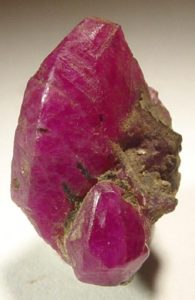

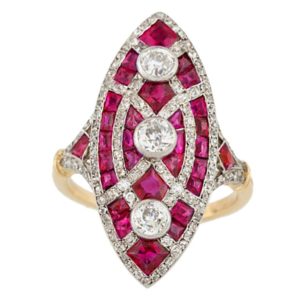
Next month: Roar with the fiercest Fire sign as Leo radiates solar power!
Get more like this—Sign up for our daily inspirational newsletter for exclusive content!
__
Photo: All photos courtesy of pexels.com, with exception of MGK photo from Wikimedia Commons




